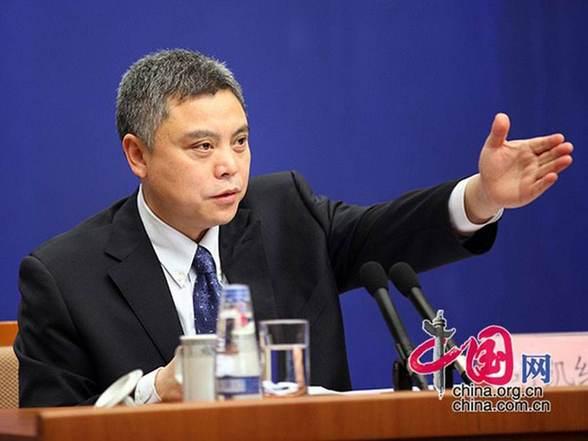



Speaker:
Xiao Yaqing, chairman of the State-owned Assets Supervision and Administration Commission of the State Council
Chairperson:
Hu Kaihong, spokesperson of the State Council Information Office
Date:
Sept. 28, 2017

Hu Kaihong:
Ladies and gentlemen, good morning. Welcome to the press conference. As we know, many people are paying close attention to the reform of state-owned enterprises (SOEs), and are eager to know what has happened so far.
Today, we are delighted to invite Mr. Xiao Yaqing, the chairman of the State-owned Assets Supervision and Administration Commission (SASAC) of the State Council, to introduce the progress of reforms since the 18th National Congress of the Communist Party of China (CPC). He will also answer some of your questions.
Also present at the press conference are: Ms. Huang Danhua, SASAC vice chairwoman, and Mr. Peng Huagang, SASAC deputy secretary-general and spokesperson.
Now, let's welcome Mr. Xiao Yaqing to make his briefing.
Xiao Yaqing:
Thank you. Ladies and gentlemen, good morning. It's a great pleasure for me to be here with you.
Now, I would like to present a brief introduction to the reform of SOEs, especially centrally-administered SOEs, since the 18th CPC National Congress.
The CPC Central Committee attaches great importance to the reform and development of SOEs. Since the 18th CPC National Congress in 2012, the CPC Central Committee with Comrade Xi Jinping at its core has specified the direction and plans for the reform. The Committee pushed it forward with unprecedented determination and strength, as demonstrated by the series of major decisions it has made. General Secretary Xi Jinping has given a number of important speeches and instructions on the direction of the reform. Premier Li Keqiang has also clarified on multiple occasions the requirements for the reform and development of SOEs.
Subdivisions of the SASAC at every level and all SOEs, especially those centrally-administered SOEs, have worked in accordance with these plans and requirements. Remarkable results have been achieved in comprehensively advancing the reform and making breakthroughs in key areas.
Over the past five years, we have essentially completed top-level design of SOE reform and paid extra attention to implementing systematic, integrated and coordinated reforms. The Party Central Committee and the State Council have put in place a framework that consists of the Guidelines on Deepening Reform of SOEs as well as 22 supplementary documents, which have played an important role in guiding and leading practice at the grassroots level. Central and local SOEs have kept to a problem-oriented approach, adopted work plans and detailed implementation rules in view of their own circumstances, and intensified reform of SOEs.
In the five years, significant measures for SOE reform were implemented one by one. Breakthroughs occurred continually in regard to those key and difficult issues. Centrally-administered SOEs' classification reform was carried out comprehensively so that their functions were defined more precisely. There were 10 pilot reforms, all of which made significant progress and established many precedents and experiences that can be copied and replicated. More than 90 percent of the SOEs have undergone corporate system reform, along with about 92 percent of the branches and subsidiary companies under centrally-administered SOEs. Mixed ownership reform was carried forward in a stable way, and more than two-thirds of the central enterprises have introduced or are in the process of introducing capital from various social source in order to promote shareholding diversity. The regrouping and integration of SOEs is also been advanced in a significant way. The SOE structure is constantly being optimized through regrouping of the State-owned capital layout. The three key institutional reforms have achieved further progress. The supervisory function related to State-owned assets was further transformed, with continuously strengthened oversight. Party building was enhanced comprehensively, providing solid assurances for the development and reform of SOEs.
During the past five years, the SOEs have made big strides while gradually releasing the reform dividends. They have improved the market-oriented institution during the ongoing reforms, exemplified by the intensified operational controls of the centrally-administered ones, the quality, efficacy and vitality of which have continuously progressed.
By 2016, the aggregate assets of the centrally-administered SOEs grew to 50.5 trillion yuan, an 80 percent surge compared to the previous Five-Year Plan. Meanwhile, benefits over the five years reached 6.4 trillion, up 30.6 percent from their last quintuple effort, registering comparatively high growth.
The amount of taxes and fees paid was 10.3 trillion yuan in 2016, up 63.5 percent, and the good momentum was sustained in the first eight months of this year. The centrally-administered SOEs have secured historically high year-on-year growth represented by the 15.7 percent increase in revenues and 17.3 percent surge in gross profits.
The achievements made in the reform and development of SOEs has well proven the brilliance and correctness of the CPC Central Committee's policies on SOE reforms. These reforms and policies are completely in line with China's national conditions and market economy laws as well as the laws of corporate growth, and have won the sincere support and enthusiastic participation of SOE staff.
Meanwhile, we also know that the SOE reform has a long way to go. We have a lot of work to do to implement the requirements by the central government. Standing at a new higher starting point, we will double our effort in further deepening and implementing reforms and finding solutions to problems. We will push through the reform of SOEs to make them stronger, better and larger.
Now, my colleagues and I would like to take your questions.
Hu Kaihong:
Thank you, Mr. Xiao. Now, the floor is open for questions. Please identify yourself before asking your question.
